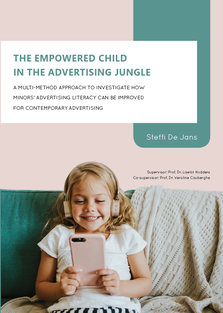Improving children's advertising literacy
Researcher(s): Steffi De Jans
Promotors: Liselot Hudders and Veroline Cauberghe
Duration: November 2015 to January 2020
Description
Due to minors’ changing media landscape and the fact that they are an important target group for advertisers, children and adolescents are daily exposed to numerous contemporary advertising messages. This contemporary advertising differs from traditional (television, print, outdoor) advertising on different aspects. Contemporary advertising integrates the commercial content into the media content, blurring the boundaries between advertising and entertainment. In addition, this advertising is often interactive, whereby it strongly involves minors with the advertising content. Furthermore, contemporary advertising is fun and appealing, mainly responding to minors’ emotions. These characteristics make it a very difficult task for minors to recognize the commercial content and critically reflect on it, which makes them vulnerable to the persuasive power of contemporary advertising. Previous research has indeed shown that minors are susceptible to the effects of contemporary advertising and that they have less advertising literacy for contemporary advertising compared to traditional (television) advertising. Advertising literacy refers to all knowledge and skills one has related to advertising, and is assumed crucial for minors to cope with advertising and avoid subconscious persuasion.
Therefore, the main aim of the dissertation is to make children (ages six to twelve) and adolescents (ages 13 to 18) more resilient to contemporary advertising by examining how their advertising literacy can be improved through different advertising literacy interventions. In particular, three research objectives are investigated. The first research objective aims to examine the effectiveness of a traditional classroom intervention on children’s advertising literacy for contemporary advertising. In addition, the second research objective aspires to develop a serious mini-game platform to enhance adolescents’ advertising literacy (research objective 2a), and subsequently test the serious mini-game platform’s effectiveness (research objective 2b). Finally, the third research objective aims to investigate how an advertising disclosure that effectively discloses all contemporary advertising to minors should be designed (research objective 3a). In addition, this research objective also aims to examine the advertising disclosure’s effectiveness in terms of increasing children’s and young adolescents’ advertising literacy for contemporary advertising (research objective 3b). In sum, the effectiveness of three advertising literacy interventions (i.e. traditional classroom intervention, serious mini-game platform and advertising disclosure) is examined, of which two interventions are also developed within this dissertation (i.e. serious mini-game platform and advertising disclosure).
To meet the main aim of the dissertation and answer the research objectives, one literature review and six empirical studies are conducted. The dissertation focuses on children (ages six to twelve) and adolescents (ages 13 to 18) as the two main age groups, and reports data collected from 1.098 Belgian minors between six and 18 years.
Full description and dissertation available here.
